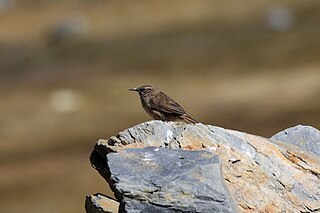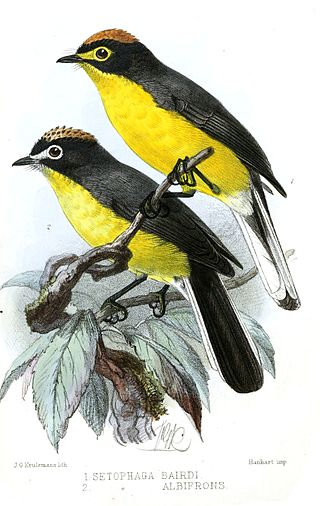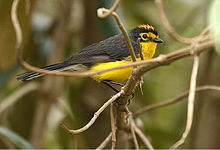
The spectacled bear, also known as the South American bear, Andean bear, Andean short-faced bear or mountain bear and locally as jukumari, ukumari (Quechua) or ukuku, is a species of bear native to the Andes Mountains in northern and western South America. It is the only living species of bear native to South America, and the last remaining short-faced bear. Its closest relatives are the extinct Tremarctos floridanus, and the giant short-faced bears, which became extinct at the end of the Pleistocene around 12,000 years ago. The diet of the spectacled bear is mostly herbivorous, but it occasionally engages in carnivorous behavior. The species is classified as Vulnerable by the IUCN because of habitat loss.

The painted redstart or painted whitestart is a species of New World warbler found in mountainous areas across inland Central America. They are among the largest warblers, reaching the length of 6 inches (150 mm), tail included. Adult birds have glossy black plumage, with white strips on the wing and a bright red belly. Female and male birds have similar appearance. Female painted redstarts have a rare feature of being as good singers as the males.

The collared whitestart, also known as the collared redstart, is a tropical New World warbler endemic to the mountains of Costa Rica and western-central Panama.

Whitestarts are New World warblers in the genus Myioborus. The English name refers to the white outer tail feathers which are a prominent feature of the members of this genus. The species in this genus are also often called "redstarts".

The black-headed parrot is a species of bird in subfamily Arinae of the family Psittacidae, the African and New World parrots. Other colloquial names are black-crowned parrot, black-capped parrot, black-headed caique, and for subspecies P. m. pallidus, pallid caique. It is found in Brazil, Colombia, Ecuador, French Guiana, Guyana, Peru, Suriname, and Venezuela.

The streak-throated canastero is a species of bird in the Furnariinae subfamily of the ovenbird family Furnariidae. It is found in Bolivia and Peru.

The montane woodcreeper is a perching bird species in the subfamily Dendrocolaptinae of the ovenbird family Furnariidae. It is found in Bolivia, Colombia, Ecuador, Peru, and Venezuela.

The white-fronted whitestart or white-fronted redstart is a species of bird in the family Parulidae. It is endemic to forest and woodland in the Andes in western Venezuela. It is threatened by habitat loss.

The brown-capped whitestart or brown-capped redstart is a species of bird in the family Parulidae. It is found in humid Andean forests and woodlands in Bolivia and north-western Argentina. It sometimes includes the tepui whitestart as a subspecies.

The tepui whitestart or tepui redstart is a species of bird in the family Parulidae. It is found in humid highland forest, woodland and scrub in the tepuis in southern Venezuela, western Guyana and northern Brazil. It is sometimes included as a subspecies of the brown-capped whitestart.

The yellow-crowned whitestart, Santa Marta whitestart or yellow-crowned redstart, is a species of bird in the family Parulidae. It is endemic to the highland forest and woodland in the Santa Marta Mountains in Colombia.

The slate-throated whitestart or slate-throated redstart is a species of bird in the family Parulidae native to Central and South America.

The golden-fronted whitestart or the golden-fronted redstart, is a species of bird in the family Parulidae. It is found in forest, woodland and scrub in the Andes of Colombia and far western Venezuela.

The Paria whitestart, also known as the Paria redstart, yellow-faced whitestart or yellow-faced redstart, is a species of bird in the family Parulidae. It is endemic to the Paria Peninsula in Venezuela, where it occurs in humid forests, especially near the edge. It is threatened by on-going habitat loss within its tiny range.

The elegant woodcreeper is a species of bird in the subfamily Dendrocolaptinae of the ovenbird family Furnariidae. It is found in Bolivia, Brazil, Colombia, Ecuador, and Peru.

The black-tailed trogon is a species of bird in the family Trogonidae, the quetzals and trogons. It is found Panama and northern South America.

The fauna of Colombia is characterized by a high biodiversity, with the highest rate of species by area unit worldwide.

The Venezuelan Andes montane forests (NT0175) is an ecoregion in the northern arm of the Andes in Venezuela. It contains montane and cloud forests, reaching up to the high-level Cordillera de Merida páramo high moor ecoregion. The forests are home to many endemic species of flora and fauna. Their lower levels are threatened by migrant farmers, who clear patches of forest to grow crops, then move on.




















